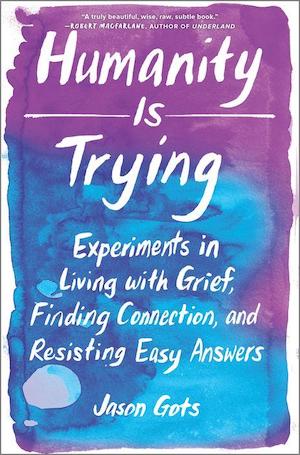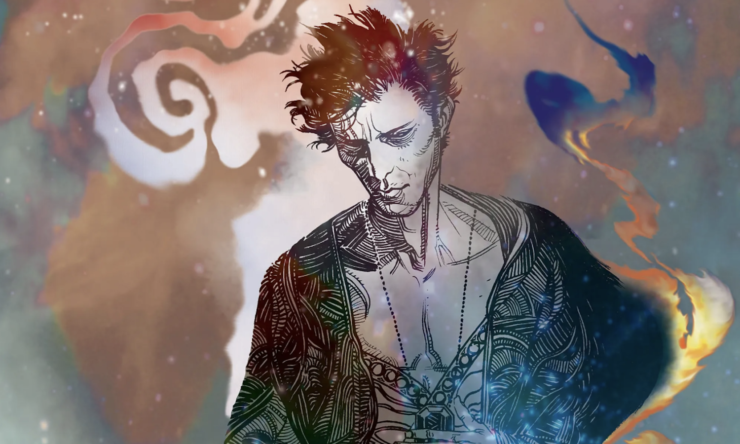Stories—like the words they’re made of—are things of power. And power is hard to control. Telling and learning from stories is so deeply wired in our brains that we need to be especially attentive to how we use that power, and how it sometimes uses us.
Lately I’ve been rereading The Sandman—a series of comic books written by Neil Gaiman, originally published by DC Comics’ Vertigo imprint when I was in high school and college. It ran 75 issues, from 1989 to 1996, and, with its sweeping, multi-issue story arcs, was one of the first series to achieve the highbrow literary distinction of “graphic novel.” Along with Alan Moore’s Watchmen, Art Spiegelman’s Maus (which won a Pulitzer Prize in 1992), and Frank Miller’s Dark Knight series of noir Batman comics, it was responsible for a kind of critical reevaluation of the medium across the literary world: “Comics: they aren’t just junk food anymore!” For their creators, all of whom had grown up inspired by comic books and knowing them for what they were—angel’s food for the soaring imagination—being turned into poster boys for “worthwhile” comics must have been an awkward feeling at best.
For me, a disaffected, darkly romantic-leaning suburban teen, The Sandman was a revelation. I had read plenty of comic books: X-men and Fantastic Four at sleepaway camp during rainy afternoons in my bunk bed, and, through my high school best friend John, earlier “prestige” series like Miracleman (called Marvelman in the UK), Alan Moore’s Swamp Thing, The Incal by French artist Jean Giraud (AKA Moebius), and the gleefully lowbrow police-brutality burlesque Judge Dredd.
Of all the things I’ve ever read (with the possible exception of Shakespeare’s Hamlet), Sandman has lodged itself most deeply in my consciousness, shaping the way I’ve moved through the world these past 30-odd years since I first read it. My memory’s pretty unreliable, so it’s not that I recall every detail of plot and character. The big picture, yes: Morpheus, the antihero, is one of seven Endless—eternal beings that aren’t quite gods, though they have god-like powers. His siblings include Death (pictured as a beautiful young Goth girl à la Siouxsie Sioux of the post-punk band Siouxsie and the Banshees, just as Morpheus is clearly an homage to Robert Smith of The Cure), Desire, Despair, Delirium (who once, long ago, used to be Delight), Destiny, and Destruction. Morpheus is the lord of dreams; his realm, The Dreaming, which all of us visit in our sleep.
Morpheus, like his creator Neil Gaiman, is a storyteller, the Dreaming a land of stories. In the Dreaming, there is a library of books by known authors—books they wholly or partially dreamt into being, but never wrote in the waking world. In “A Season of Mists,” Gaiman gives us a quote from one of these nonexistent books: The Man Who Was October, by G.K. Chesterton:
October knew, of course, that the action of turning a page, of ending a chapter or of shutting a book, did not end a tale.
Having admitted that, he would also avow that happy endings were never difficult to find: “It is simply a matter,” he explained to April, “of finding a sunny place in a garden, where the light is golden and the grass is soft; somewhere to rest, to stop reading, and to be content.
We tend to think of stories as self-contained, unchanging things with a beginning, a middle, and an end. But dreams teach us that stories are woven from fragments of memory and imagination—that the formal, written stories we know are barely contained within their pages. Once we’ve read or heard them, they forever form part of the fabric of our consciousness, informing our thoughts and our lives in ways we’re hardly aware of. Plot is important. But what we care about, what carries us through the story, is character. We’re humans, after all—mammals—wired from birth to care about how other humans feel and what happens to them.
By making the connection between dreaming and storytelling explicit (as Shakespeare does repeatedly throughout his work), Gaiman reminds us that our lives are afloat on this ocean of narrative. Out of it, we spin the stories of who we think we are. We get caught up in other people’s stories of themselves and the ones we tell about them. In The Sandman (as in other Neil Gaiman works, like the novels Neverwhere and American Gods) gods like the Norse Odin or the Egyptian Bast, characters like Alice (of Wonderland fame) or the biblical Cain and Abel, angels like Lucifer Morningstar (AKA Satan) travel beyond the borders of the stories we’ve heard about them. They get swept into new stories inside the Dreaming, as the boundaries between their fictional worlds collapse. They’re bound, as we all are, to be themselves, but having once been created, they never really end, not even in death. Omnia mutantur, nihil interit, quotes Morpheus from Ovid’s metamorphosis: “Everything changes, but nothing is truly lost.”
The Biblical Cain and Abel, for instance, live at the entrance to the Dreaming, forever reenacting their ancient roles of murderer and victim, living out a slightly different story each time Abel is reborn. Other characters broaden their horizons: Shakespeare’s trickster-fairy Puck in Gaiman’s reimagining of A Midsummer Night’s Dream murders the actor Will Kemp and takes his place (in the role of Puck) onstage. Later, in league with another trickster, the Norse God Loki, he unwittingly sets in motion a story to end all stories.
In 2015, my only sibling, my younger sister Meri, died. Causes unknown, but it was probably related to a cocktail of medications she was on for phantom limb pain, the result of an amputation which was itself the result of a childhood cancer from years earlier. In the aftermath of her death, I thought a lot about stories. I thought about how she—my brilliant, beautiful, one-of-a-kind sister—had been reduced in my imagination and those of so many others to a tragedy of wasted potential—of the “life that might have been.” I wondered how a shabby little story of decline and death could have swallowed up a person more alive (when she was alive) than anyone else I’ve ever known. The memoir I wrote about her became, in some ways, a critique of stories as dangerous things—compelling little mnemonics we tell ourselves over and over until they start to tell us.
The most popular article I ever wrote for Big Think, a media company where I worked from 2010 to 2020, was called “Your Storytelling Brain.” In it, I gushed about the research of Michael Gazzaniga, a neuroscientist who has studied narrative memory—the memory function that enables us to string together incidents: a snub on the fifth grade soccer field, an admired professor’s praise, ecstatic reactions to your home-smoked salmon—into a coherent sense of self. I wrote about narrative memory as a wondrous thing, the basis (as it is) for our love of all kinds of storytelling, beginning in toddlerhood and continuing through our entire lives. This was 2012, and the short article struck a nerve among a rising crop of influencers and lifestyle branding gurus who, at the time, were obsessed with storytelling as an elemental force for connecting with audiences (in order to gain their trust and ultimately, in a roundabout way, to sell them things). I was no marketer. As far as I can remember, I wrote the piece as an honest expression of my awe at the human brain and the power of stories.
But in the three years since writing it, up to the time of my sister’s death in 2015, Buddhist studies and practice had made me increasingly skeptical of the narrative self. They had taught me to try and look past stories into moment-to-moment reality as it is. It was my understanding at the time that the stories we tell ourselves about who we are, who we’ve been, and what we want out of life often get in the way of living. And when Meri died and I found myself stuck holding the story of her unfinished, unfulfilled life, I started searching for the anti-story that could bring my sister back to me. Writing the memoir, I tried to unravel some of the narrative threads that were keeping my memories of her bound and dead.
Fittingly, the Sandman’s story-realm is morally neutral. Happy dreams of flying unicorns share space with nightmare serial killers who eat human eyeballs. Stories have their places. Their duties and purposes. And when that order is, inevitably, disrupted—as when Morpheus is imprisoned for 70 years by an Aleister Crowley-like occultist in England—trouble ensues. In the American context, to give a real-world example, “Liberty” is an old story that hangs around waiting to be retold, as useful for ending slavery as it is for propping up the gun industry or empowering people not to vaccinate themselves against disease. When stories escape, they get up to all manner of mischief. Lover of stories though he is, I think Gaiman might agree with me that our storytelling brains are as good at breeding monsters as they are at slaying them.
That said, since writing the memoir the pendulum has swung for me back toward the middle. I don’t think it’s possible, nor desirable to live in a world without stories. In the chronicles of the Buddha, he tells stories constantly. If he’s trying to help his students unravel the self by teaching them to them dismantle the traps of narrative memory, why fill their brains with more stories? In one of his more famous metaphors, he describes his teachings as a boat across a river. Once you’re across the river, you don’t need the boat anymore. Similarly, the stories we tell ourselves about our lives can be liberating vehicles, or they can be prisons. We have to be careful which stories we tell.
Rereading The Sandman, I’m filled first with delight by how clever and beautiful are the worlds Gaiman and his collaborators created. What a joy it has been to revisit them. Then I’m reminded that the best stories—Sandman’s among them—are the ones that help us see past them, see through them, and in doing so, see more deeply into ourselves.
Buy the Book


Humanity Is Trying
Jason Gots is a writer, podcaster, and singer-songwriter. He’s the author of the memoir Humanity is Trying: Experiments in Living with Grief, Finding Connection, and Resisting Easy Answers (HarperCollins). He produces and hosts Clever Creature, an experimental variety podcast of songs, short fiction, and conversation. From 2015-2020 he produced Think Again – a Big Think Podcast, interviewing artists and thinkers including Terry Gilliam, Margaret Atwood, Neil Gaiman, Neil DeGrasse Tyson, and many more. His record Box of Notebooks (songs 1992-2018) is available on all streaming platforms. Jason currently teaches Narrative Podcasting in Columbia University’s graduate writing program and lives in Astoria, New York with two people and multiple animals he wouldn’t want to live without.










